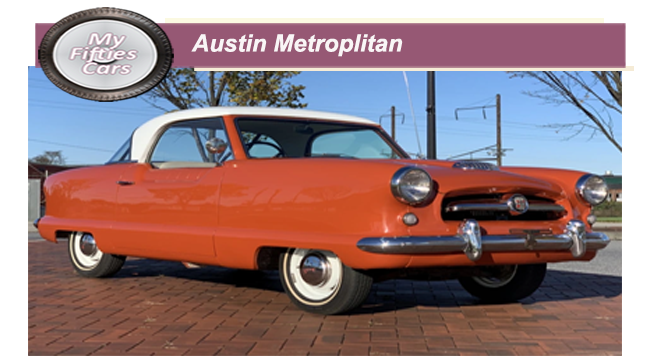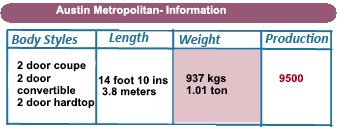
The Metropolitan was a small, two-door car produced under licence by Austin Motors in the years 1954 to 1961.
Based on a design developed by US auto giant Nash Motors, the Metropolitan was developed to be a fuel-efficient and affordable alternative to the larger, more expensive cars that were dominating the US market during the Fifties.
 Far from being the fastest car of its day nor the most agile, the Nash Metropolitan held a curious appeal in the austere times of the early Fifties.
Far from being the fastest car of its day nor the most agile, the Nash Metropolitan held a curious appeal in the austere times of the early Fifties.
To begin with the Metropolitan t served as one of the earliest examples of post-war joint ventures, whereby a car would mix mechanical components and styling from two countries.
 The Ultimate Metropolitan evolved from an NXI (Nash Experimental International) prototype, which in turn became the Nash-Kelvinator International. The concept peaked shortly after World War II when Nash president. George W. Mason ordered research to begin on a compact road car.
The Ultimate Metropolitan evolved from an NXI (Nash Experimental International) prototype, which in turn became the Nash-Kelvinator International. The concept peaked shortly after World War II when Nash president. George W. Mason ordered research to begin on a compact road car.
 Bill Flajole, an independent stylist, was one of many who was invited to submit a design proposal to Mason. Flajole’s design was based on the chassis and running gear of a tiny Fiat 500. In fact, early rumours suggested that the resulting car would use a Fiat engine.
Bill Flajole, an independent stylist, was one of many who was invited to submit a design proposal to Mason. Flajole’s design was based on the chassis and running gear of a tiny Fiat 500. In fact, early rumours suggested that the resulting car would use a Fiat engine.
To gauge feedback, George Romney who would go on to become head of American Motors, displayed the prototype to US dealers and the press at a series of private unveilings held in early 1950 to gauge public reaction.
![]()
 Featuring a compact, four-seat body with a rear-mounted engine, the Austin Metropolitan was powered by a 1.2-liter inline-four engine. It was available in both hardtop and convertible body styles and was marketed as a stylish and practical car for urban drivers.
Featuring a compact, four-seat body with a rear-mounted engine, the Austin Metropolitan was powered by a 1.2-liter inline-four engine. It was available in both hardtop and convertible body styles and was marketed as a stylish and practical car for urban drivers.
Late in 1953, a deal was struck with Austin to begin volume production. Bodies for the Metropolitan would be produced in Britain by Fisher & Ludlow of Birmingham, then shipped to the Austin plant at Longbridge for final assembly.

The Metropolitan was powered by a 1200-cc (73-cid) engine fitted on the Austin A40 produced 42 horsepower. The sole transmission was a three-speed manual unit with a column-mounted gearshift lever (which spectacularly emerged from the instrument panel). A single-plate Borg & Beck clutch was used.
 Front suspension was Nash's "Airflex" setup, with a coil spring between the wheel housing and upper control arm, and Metropolitans also adopted the Nash "Airflyte" unit body construction.
Front suspension was Nash's "Airflex" setup, with a coil spring between the wheel housing and upper control arm, and Metropolitans also adopted the Nash "Airflyte" unit body construction.
A flat, one-piece windshield and a three-piece, curved rear window were standard with both body styles.
![]()
 The Austin Metropolitan was well-received when first introduced, gaining considerable attention in the United Kingdom and other European countries. because of its unconventional design and outstanding colour schemes.
The Austin Metropolitan was well-received when first introduced, gaining considerable attention in the United Kingdom and other European countries. because of its unconventional design and outstanding colour schemes.
Metropolitans went on sale early in 1954. A second series, the 1500, debuted in April 1956 with a bigger engine (the Austin A50) and more power, as well as bright two-tone color schemes.
 However, as the years went by, the Metropolitan struggled to compete with more modern and advanced small cars introduced later in the decade, and production of the Metropolitan ended in 1961. Despite its limited success, the Austin Metropolitan remains a notable and collectible car today.
However, as the years went by, the Metropolitan struggled to compete with more modern and advanced small cars introduced later in the decade, and production of the Metropolitan ended in 1961. Despite its limited success, the Austin Metropolitan remains a notable and collectible car today.
Around 9,500 Austin Metropolitans were sold during its seven-year production run. Far from being a best seller, Metropolitans did find a comfortable niche among the young and upwardly mobile generation of the early Fifties.


